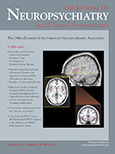A Case of Anti-NMDA Receptor Encephalitis With the Highest Reported CSF White Cells to Date
To the Editor: The authors report a case of anti–N-methyl-d-aspartic acid receptor (NMDAR) encephalitis in a woman with a history of depression and alcohol use.
Case Report
A 39-year-old woman with a history of depression and chronic alcohol excess (40 U/week) presented to the emergency department with a 1-week history of malaise, hallucinations, poor balance, photophobia, headache, and confusion. The initial Glasgow Coma Score was 13/15, with no focal neurology or meningism. All other observations were stable. A CT head scan revealed no abnormalities. Alcohol withdrawal was thought to be the likely cause of her symptoms; however, a lumbar puncture revealed a raised CSF protein level (1.4), a markedly raised white cell count (280/mm3, 65% lymphocytes), and a reduced glucose level of 2.2 mmol/L (serum, 5.1 mmol/L).
Infective encephalitis was considered to be the likely diagnosis, and intravenous meropenem and acyclovir were immediately started. The patient’s condition rapidly deteriorated, with twitching, intermittent agitation, and tachypnoea. PRN chlordiazepoxide was started to treat the possibility of a superimposed alcohol withdrawal syndrome. The Glasgow Coma Score fluctuated between 9 and 13, and the patient was admitted to the ITU for respiratory support. Meropenem was discontinued after 5 days following negative CSF and blood cultures. Acyclovir was continued for 10 days, although polymerase chain reaction for HSV was negative. A lumbar puncture was repeated on day 6 for virology. Polymerase chain reaction was negative. There was no clinical improvement during this time. An MRI scan of the brain showed no obvious changes, and EEG scans revealed a background encephalopathy with no underlying seizures.
Six days after admission, blood samples were sent for NMDAR and anti–thyroid peroxidase antibodies. The patient’s condition remained poor but stable over the following weeks, with intermittent episodes of agitation, confusion, low-grade pyrexia, and fluctuating conscious level. Another trial of intravenous meropenem caused a possible Clostridium difficile infection, which was treated with vancomycin. Anti-NMDAR antibodies were confirmed in the patient’s blood 24 days after admission. Following a further 10 days without significant improvement, intravenous immunoglobulin was given followed by intravenous methylprednisolone and a long course of oral steroids. The patient’s condition gradually improved, and she was discharged from the ITU on day 44 before an extended period of recovery on the ward. The patient was eventually discharged 102 days following admission on steroids with a community neuropsychiatric rehabilitation plan.
Discussion
This case highlights the diagnostic uncertainty surrounding anti-NMDAR encephalitis and demonstrates the significant overlap in both clinical picture and laboratory tests between this condition and the more commonly seen infective encephalitides (9). The Californian Encephalitis Project, a major review of young patients that aimed to characterize encephalitic etiologies, suggested that the median CSF white cell count is significantly lower in anti-NMDAR encephalitis than in other etiologies.1 The cell count in our example is the highest seen in the literature and is significantly higher than the median of 32 and 23 seen in the largest case series to date and the Californian Study, respectively.1,2 Our example demonstrates that NMDAR antibody encephalitis should be considered and investigated even in light of evidence strongly supporting an infective etiology. This is essential if diagnostic lag is to be improved from the current median of 6 weeks.3 Earlier treatment would likely reduce the mortality of this condition and improve the chances of a full or almost full recovery.2,4
1 : The frequency of autoimmune N-methyl-D-aspartate receptor encephalitis surpasses that of individual viral etiologies in young individuals enrolled in the California Encephalitis Project. Clin Infect Dis 2012; 54:899–904Crossref, Medline, Google Scholar
2 : Anti-NMDA-receptor encephalitis: case series and analysis of the effects of antibodies. Lancet Neurol 2008; 7:1091–1098Crossref, Medline, Google Scholar
3 : Anti-N-methyl-D-aspartate receptor (NMDAR) encephalitis in children and adolescents. Ann Neurol 2009; 66:11–18Crossref, Medline, Google Scholar
4 : Treatment and prognostic factors for long-term outcome in patients with anti-NMDA receptor encephalitis: an observational cohort study. Lancet Neurol 2013; 12:157–165Crossref, Medline, Google Scholar



